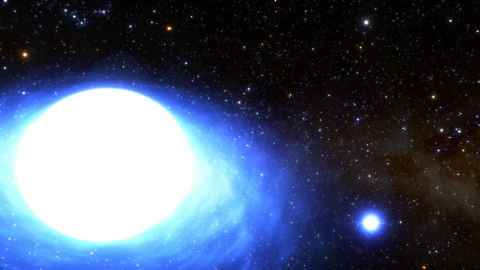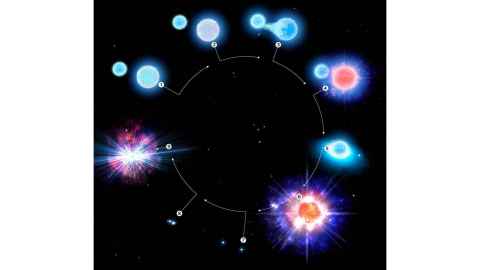Vanishingly rare stars identified after `wimpy' supernova
3 February 2023
Only about 10 star pairs like this one may exist in the galaxy, Professor Jan Eldridge and colleagues say.

Among hundreds of billions of stars in our galaxy, two have been identified as vanishingly rare by University of Auckland astrophysicist Professor Jan Eldridge and her international collaborators.
Located in a constellation near Sirius, the brightest star in the night sky, the pair may be one of only about 10 such pairs in the galaxy, according to Eldridge.
As a world expert on the evolution of binary stars, pairs of stars which orbit each other, Eldridge’s computer modelling helped establish the stars’ story.
The research has been published in leading journal Nature and is attracting attention around the world, including this article published by CNN.
Many people know of supernovae, massive stars exploding with colossal force as they run out of nuclear fuel in their cores. The cores collapse and the explosions create neutron stars.

What Eldridge and colleagues have found is something much rarer, a scenario where the supernova was a fizzer, like a damp firecracker… a wimpy supernova.
With a regular supernova, the force of the explosion gives the neutron star a big kick, so it flies off at hundreds of kilometres per second and develops an elliptical orbit. But that didn’t happen in this case.
The gravitational pull of the neighbouring star stole most of the mass of the exploding star, leading to a weaker explosion, called an “ultra-stripped supernova.” So there was no big kick, and consequently no elliptical orbit.
“What really sets this system apart is the circular orbit, much like the Earth going around the Sun,” says Eldridge. “This star system has evolved in a very rare and strange way.”
Stars make the elements needed for life, so understanding stars is to understand where we come from
The two stars will eventually create a kilonova, as the pair collide and explode, releasing gold and other elements.
Making computer models of how stars are born, live and die, what you could call a “synthetic universe,” Eldridge’s research helps to establish the meaning of astronomers’ observations.
“Stars make the elements needed for life, so understanding stars is to understand where we come from,” she says.
The research was carried out with colleagues including at Embry-Riddle Aeronautical University in the US. The binary system’s name is CPD-29 2176 and it’s in the constellation Puppis.
Evolution of CPD-29 2176, a rare binary star system

This infographic illustrates the evolution of the star system CPD-29 2176, the first confirmed kilonova progenitor. Starting in the upper left:
- Stage 1, two massive blue stars form in a binary star system.
- Stage 2, the larger of the two stars nears the end of its life.
- Stage 3, the smaller of the two stars siphons off material from its larger, more mature companion, stripping it of much of its outer atmosphere.
- Stage 4, the larger star forms an ultra-stripped supernova, the end-of-life explosion of a star with less of a “kick” than a more normal supernova.
- Stage 5, as currently observed by astronomers, the resulting neutron star from the earlier supernova begins to siphon off material from its companion, turning the tables on the binary pair.
- Stage 6, with the loss of much of its outer atmosphere, the companion star also undergoes an ultra-stripped supernova. This process will take about one million years.
- Stage 7, a pair of neutron stars in close mutual orbit now remain where once there were two massive stars.
- Stage 8, the two neutron stars spiral into each other, giving up their orbital energy as faint gravitational radiation.
- Stage 9, the final stage of this system as both neutron stars collide, producing a powerful kilonova, the cosmic factor of heavy elements in our Universe. (Infographic source: Embry-Riddle Aeronautical University)
Media contact
Paul Panckhurst | media adviser
M: 022 032 8475
E: paul.panckhurst@auckland.ac.nz